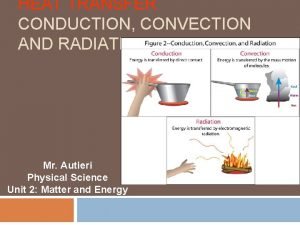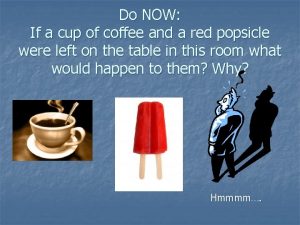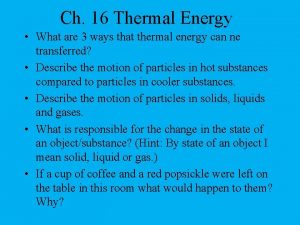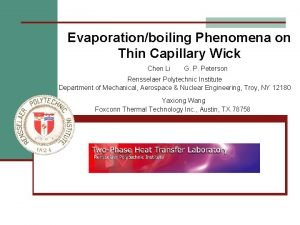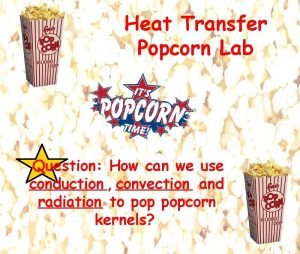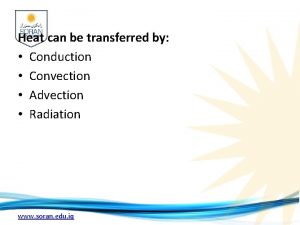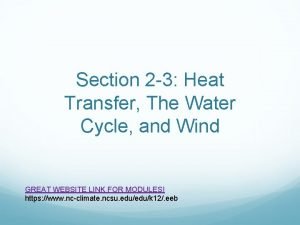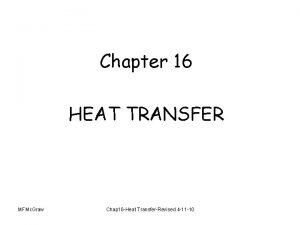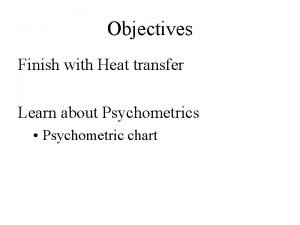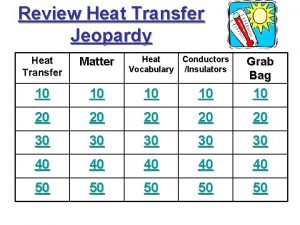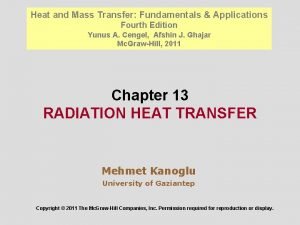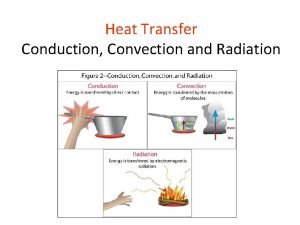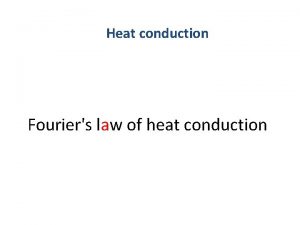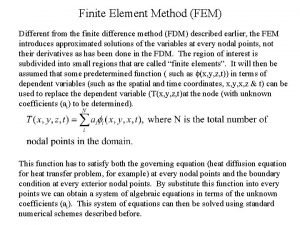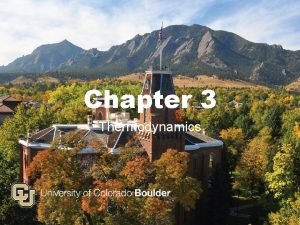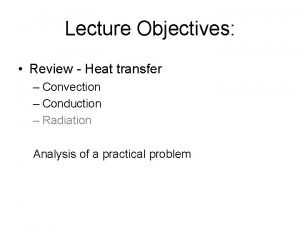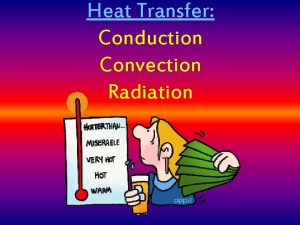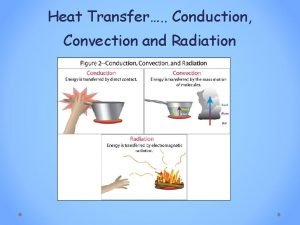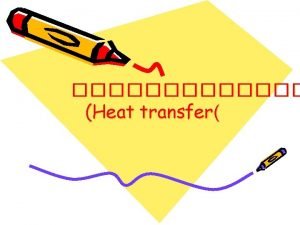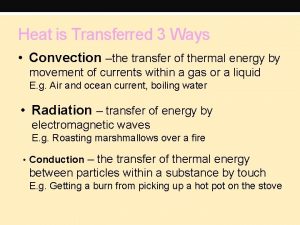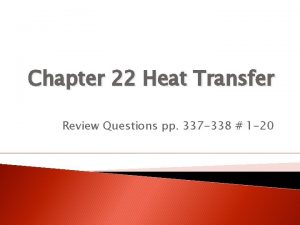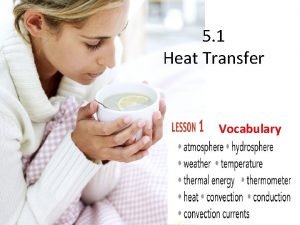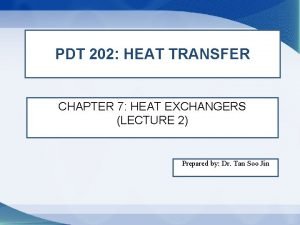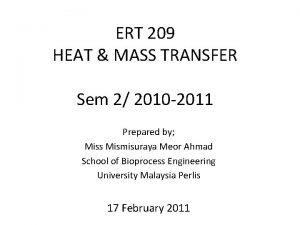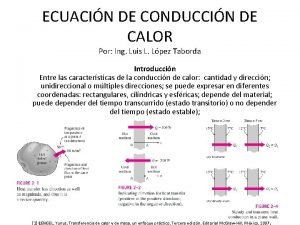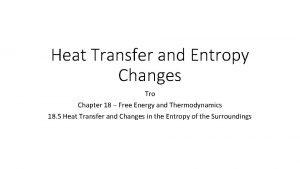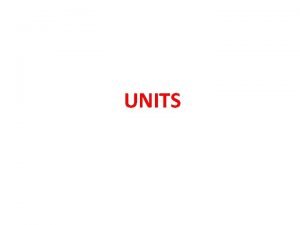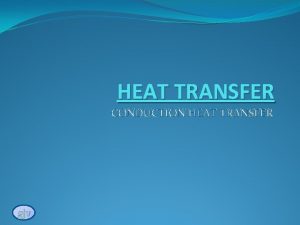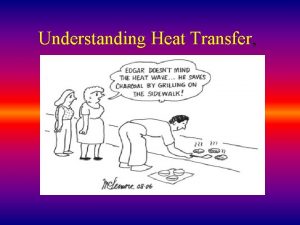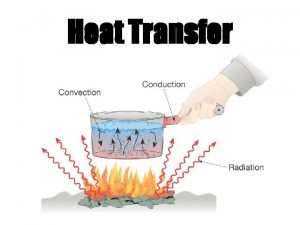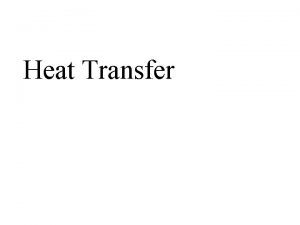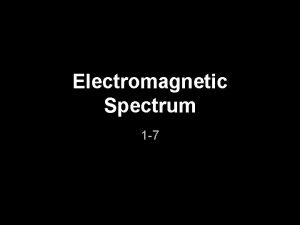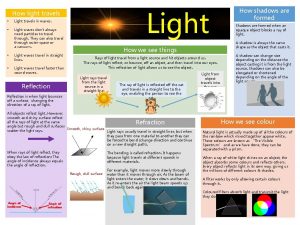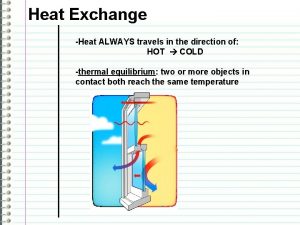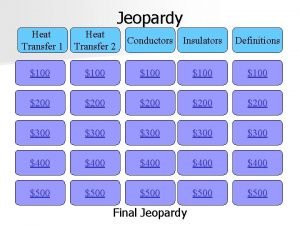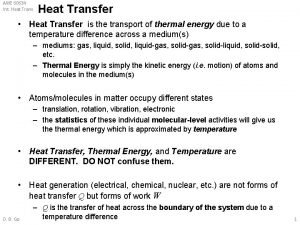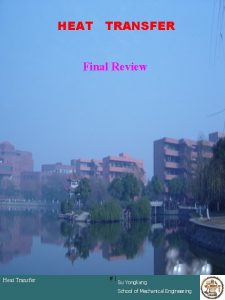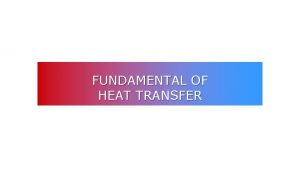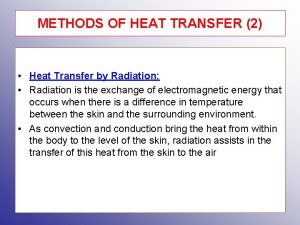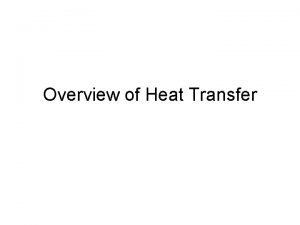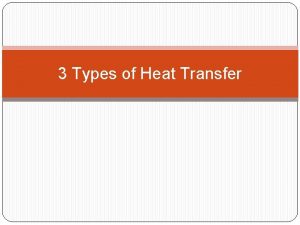Heat Transfer Heat Transfer o o Heat travels






























- Slides: 30

Heat Transfer

Heat Transfer o o Heat travels from a region of higher temperature to a region of lower temperature. This process is carried out by n n n o Conduction Convection Radiation When thermal equilibrium is reached in all regions, there is no net heat transfer.

Conduction o Conduction is the process which heat is transferred through a medium from one particle to the next.

Conduction o Heat travels at different speed through different materials. wood copper steel aluminium did not drop 14 s 73 s 16 s

Conduction o o o Good heat conductors have high heat conductivity. E. g. Copper and Silver. All substances can conduct heat. But some are exceptionally bad conductors e. g. air and gases or nonmetals. Poorest Conductor – Vacuum Poor Conductors are also good insulators of heat.

Conduction o o A test-tube filled with water has ice weighed down at its bottom. A flame is put near the top of the water and heats it up. The water on top boils but the ice does not melt. Why? Water is a poor conductor of heat. Hot water also rises, hence does not sink to the bottom of the tube to melt the ice.

Insulation of Heat Conduction o o To reduce heat conduction, insulators are used. The poorest conductors are used as heat insulators where applicable. Insulation is found in the walls of the home, on heating pipes and air-con pipes (pipe lagging), Winter clothing or the sweater that you wear

Fibreglass Insulation o o Glass is a poor conductor. Fibreglass uses this property. Layers are placed between walls to reduce heat conducted into the house in summer or conducted out of the house in winter.


Convection o o Convection is the process where heat is transferred through a fluid (gas and liquid) by the movement of heated particles of the liquid Recall movement of molecules in kinetic theory and the energy of the molecules.

Convection in Liquids o o o Hot liquids rise as they expand under heat (less dense) Cool liquids fall (relatively denser) Movement of liquids due to this effect is called the ‘convection current’

Convection in Liquids Before After Video Demo

Convection in Gases o o o Hot gases rise. Cool gases fall. Using this effect, ventilation of a room can be improved by purposeful design, or hot air retained in the winter for better effect.


Convection in Nature

Convection in Nature o o Land heats up faster in the day than the sea. Air above land is hotter and rises. Cooler air over water will come in to replace the risen hot air. Night? Earth Moving Convection Currents

Think about… o Why place the air-con on the top of air flows down to the room. the wall? Cold The warm air at the bottom will rise and get cooled. The convection current will form. o How do planetary winds form? (not the land/sea breezes) Hot air from equator flows to the colder regions of the planetary poles. Cold air from the poles is forced down to the equator, forming the planetary winds. o Why is the ventilation fan in the toilet near the top of the wall or on the ceiling?


Radiation o o o Radiation is a form of heat transfer that requires no medium to travel. Heat is transmitted in the form of energy waves. Energy travels until it gets absorbed somehow.

Radiation Emission o o o All objects above 0 K emit heat radiation This energy form is also known as infra-red. Heating objects will make it radiate more heat Dull and dark surfaces will radiate better than shiny bright surface. Bigger surfaces radiate more as well.

Radiation o Cameras designed to take infrared views of heat radiation energy are now widely used. n n n Temperature scanners at air-ports Circuit troubleshooting Imagery of space and planets Infrared picture of water vapour on Earth

Infrared Picture of Earth

infrared extreme ultraviolet visible X-ray ultraviolet Gamma rays

Radiation Absorption o o What kind of surfaces absorb radiation best? Fill middle jar with hot water and measure temperature of adjacent jars over time. HOT water

Radiation Emission o o Fill 2 similar flasks with boiling hot water. Take the temperatures of both flasks.

Radiation Absorption /Emission Results o o Dull and black surfaces absorb and emit more heat. Shiny and bright surfaces absorb and emit less heat.

Think about… o o o Kettles are shiny to reduce heat lose through radiation. It is shiny outside, but does it matter to be shiny on the inside? (its dark inside no? ) Car radiators are black. What other technology are also black for the same reason? What colour of winter clothing should you wear in winter?

Conduction, Convection and Radiation – Applying knowledge o o The Vacuum Flask (Thermos Flask) Keeps water hot (or cold) by harnessing knowledge of heat transfer reduction

Parts of the Vacuum Flask o Double Glass Walls - poor conductor o Silvered Surfaces - prevents radiation (poor absorber and emitter) o Vacuum - No conduction or convection o Insulation Supports - Reduce conduction and support the vacuum chamber o Insulated Cover - Prevent conduction of heat and convection of hot air

Think about… o What other piece(s) of technology makes use of knowledge of the 3 ways of heat transfer? Fridge, Heat Sinks, Car radiator, air con duct insulation o Your room is hot. Aside from turning on the air-con, is it more efficient to have a fan sucking the hot air out the window or blowing the cooler air into the room? (i. e. which will cool your room faster? )
 Radiation example
Radiation example Heat travels through empty space by
Heat travels through empty space by Conduction or convection
Conduction or convection Which has more thermal energy a tiger or a house cat
Which has more thermal energy a tiger or a house cat Transfer transfer
Transfer transfer Copper mesh
Copper mesh Conduction convection radiation popcorn lab
Conduction convection radiation popcorn lab Advection heat transfer
Advection heat transfer Hydrological cycle
Hydrological cycle Heat transfer cylinder
Heat transfer cylinder Law of heat exchange
Law of heat exchange Transfer learn
Transfer learn Insulators at home
Insulators at home Define radiation shield
Define radiation shield What is radiation
What is radiation Fourier's law heat transfer
Fourier's law heat transfer Governing equation heat transfer
Governing equation heat transfer Advection heat transfer
Advection heat transfer Objectives of heat transfer
Objectives of heat transfer Radiation heat transfer examples
Radiation heat transfer examples Does radiation travels in straight lines
Does radiation travels in straight lines Conduction
Conduction Boiling curve in heat transfer
Boiling curve in heat transfer 3 ways to transfer heat
3 ways to transfer heat Solar radiant energy is composed of short waves
Solar radiant energy is composed of short waves Heat transfer vocabulary
Heat transfer vocabulary Ntu in heat exchanger
Ntu in heat exchanger Bulk temperature formula
Bulk temperature formula Generación del calor
Generación del calor Q system = -q surroundings
Q system = -q surroundings Seven basic si units
Seven basic si units
